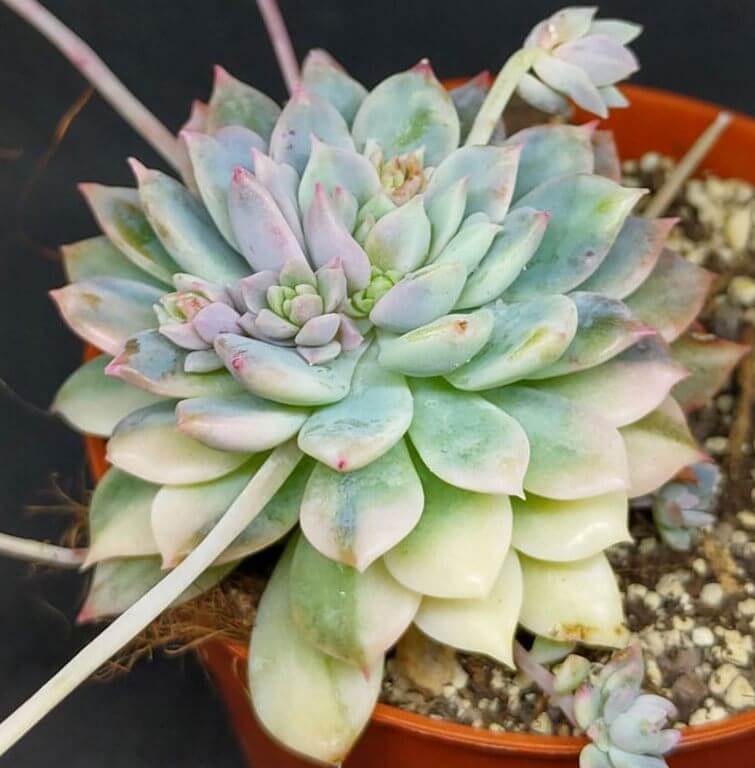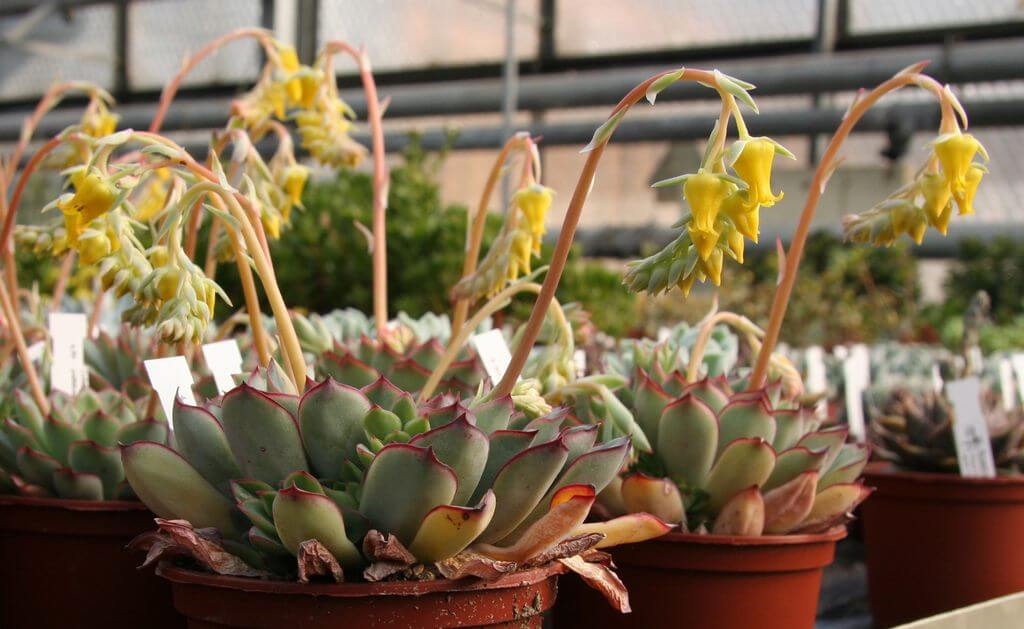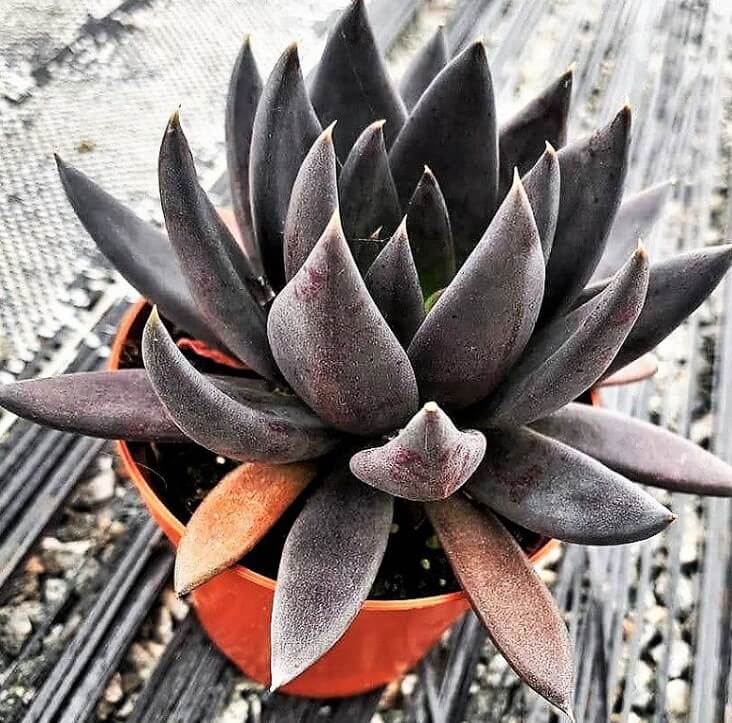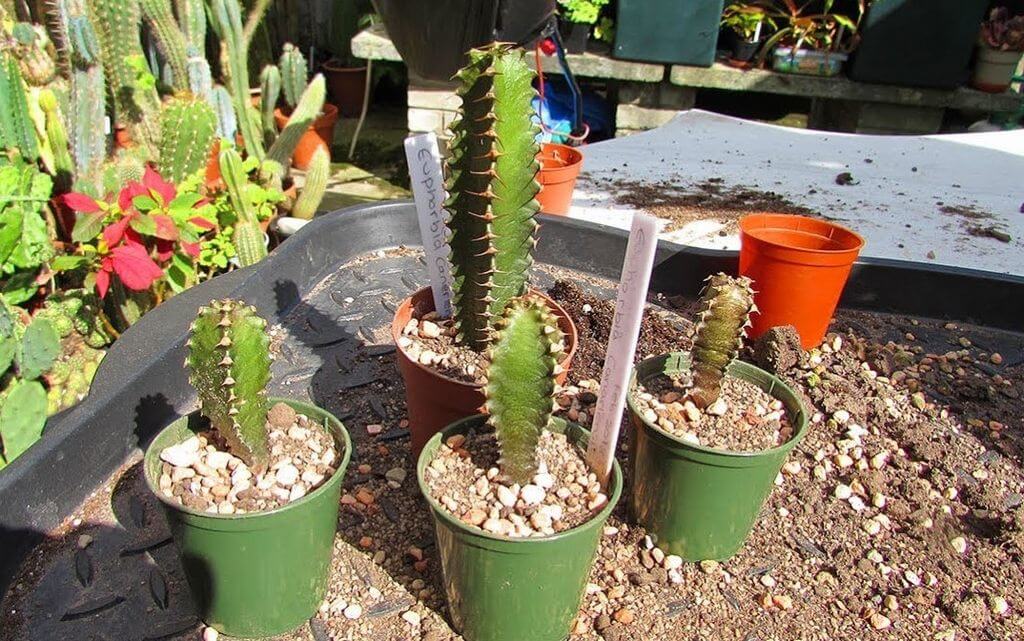Cactus Turning White
As those who care for the tough yet lonely cactus plant, we feel good about knowing and giving what these special plants need. Even the most careful of us can
Succulent plants offer a diverse range of options to enhance the beauty of your garden. With their unique characteristics and low maintenance requirements, succulents have become a popular choice among gardeners. Whether you have a spacious backyard or a small balcony, there are various types of succulents that can thrive in different environments.
Here are some popular succulent varieties that will add charm to your garden:
| Succulent | Description | Care Requirements |
|---|---|---|
| Kalanchoe Thrysiflora | This succulent, also known as “Paddle Plant,” features flat, round leaves with vibrant red edges. Its unique appearance adds a striking element to any succulent collection. | Requires well-draining soil, bright sunlight, and infrequent watering. Protect from frost. |
| Echeveria Elegans | This popular succulent, commonly referred to as “Mexican Snowball,” forms tight rosettes of pale blue-green leaves. Its compact shape and delicate texture make it a favorite among succulent enthusiasts. | Thrives in well-draining soil, partial sun, and moderate watering. Avoid overwatering to prevent root rot. |
| Sedum spp. | The Sedum genus offers a wide variety of succulents with different shapes, colors, and sizes. From groundcovers to upright plants, sedums are versatile and low-maintenance options for any garden. | Most sedums prefer full sun and well-draining soil. Water sparingly, allowing the soil to dry out between waterings. |
| Graptopetalum Amethystium | This succulent, commonly known as “Lavender Pebbles,” features rosettes of thick, fleshy leaves with a soft lavender hue. It creates a beautiful contrast when planted alongside other succulents. | Requires well-draining soil, bright light, and infrequent watering. Protect from frost. |
| Haworthia Fasciata | Also known as “Zebra Plant,” this succulent has striking dark green leaves adorned with white horizontal stripes, resembling zebra patterns. Its compact size makes it ideal for small gardens or indoor spaces. | Prefers bright, indirect light and well-draining soil. Water sparingly, allowing the soil to dry out between waterings. |
| Senecio Rowleyanus | This succulent, commonly called “String of Pearls,” features trailing stems adorned with small, bead-like leaves. Its unique trailing habit makes it a popular choice for hanging baskets or vertical gardens. | Requires bright, indirect light and well-draining soil. Water sparingly, letting the soil dry out slightly between waterings. |
| Haworthia Cuspidata | The “Star Cactus” or “Star Window Plant” is a small, compact succulent with translucent leaves arranged in rosettes. Its distinctive window-like markings allow light to penetrate the inner tissues. | Thrives in bright, indirect light and well-draining soil. Water sparingly to prevent overwatering. |
These succulents come in various shapes, sizes, and colors, making them perfect for creating beautiful succulent designs. Whether you prefer a double or triple-tiered concrete birdbath, pumpkins, driftwood, picture frames, pot in a pot, or sand, these popular succulent varieties can be creatively incorporated into your garden.

Discover the perfect succulent plants for your indoor and outdoor spaces. Succulents are not only visually appealing but also require minimal maintenance, making them ideal for both indoor and outdoor gardens. Whether you have limited space indoors or want to create a thriving succulent garden outdoors, there are specific varieties that will thrive in each setting.
Indoor succulents are well-suited for spaces with limited natural light, such as office desks or living rooms. Some popular indoor succulent varieties include Haworthia Fasciata, Kalanchoe Thrysiflora, and Senecio Rowleyanus. These plants have adapted to survive in lower light conditions and can thrive in pots or hanging baskets. Place them near a bright window or provide artificial light to ensure they receive sufficient light.
When choosing indoor succulents, it’s important to consider their growth habits. For example, some varieties, like Echeveria Elegans and Haworthia Cuspidata, grow in a rosette shape, while others, like Graptopetalum Amethystium and Sedum spp., have trailing stems. Mixing different growth habits can create a visually interesting indoor succulent garden.

For those with outdoor gardens, there is a wide range of succulent plants to choose from. Outdoor succulents thrive in direct sunlight and can withstand varying weather conditions. Some popular outdoor succulent varieties include Sedum spp., Kalanchoe Thrysiflora, and Echeveria Elegans.
When designing an outdoor succulent garden, consider incorporating different textures and colors to create an eye-catching display. Pair spiky succulents, such as Haworthia Fasciata or Agave spp., with softer, more rounded varieties like Sedum spp. or Echeveria Elegans. This contrast in shapes and textures will add visual interest to your outdoor space.
| Indoor Succulent Plants | Outdoor Succulent Plants |
|---|---|
| Haworthia Fasciata | Sedum spp. |
| Kalanchoe Thrysiflora | Kalanchoe Thrysiflora |
| Senecio Rowleyanus | Echeveria Elegans |
By carefully choosing the right succulent plants for your indoor and outdoor spaces, you can create a harmonious and beautiful garden that is easy to maintain. Whether you’re a beginner or an experienced gardener, succulents are a versatile and stunning addition to any garden.

Step into the world of rare and unique succulent species and elevate your garden’s appeal. If you’re looking to add a touch of exclusivity to your green space, these extraordinary plants are sure to captivate the attention of any visitor. With over 10,000 types of succulents in the world, there is a diverse range of rare species that will make your garden stand out from the rest.
Some of the rare succulent species worth considering include the Pincushion cactus, characterized by its cylindrical shape and vibrant flowers. The Whortleberry cactus, with its unusual branching pattern, creates an intriguing focal point in any garden. If you’re looking for something truly out of the ordinary, the Brain cactus, Candle cactus, and Grandfather cactus are sure to leave a lasting impression.
These unique succulents come in various shapes, sizes, and colors, ensuring there is something to suit every gardener’s taste. Whether you choose to showcase them in individual pots or create stunning arrangements, the rare and unique succulent species will add an element of fascination to your garden that is hard to ignore.
| Succulent Species | Description |
|---|---|
| Pincushion cactus | Cylindrical shape with vibrant flowers |
| Whortleberry cactus | Unusual branching pattern |
| Brain cactus | Intriguing brain-like appearance |
| Candle cactus | Tall, slender stems resembling candles |
| Grandfather cactus | Distinctive columnar shape and long spines |
By incorporating these rare and unique succulent species into your garden, you can create a truly remarkable landscape that showcases the beauty and diversity of the succulent world. Don’t be afraid to experiment with different arrangements and combinations to create a dynamic and visually stunning display. With these extraordinary succulents, your garden will become a captivating oasis that will leave a lasting impression on all who visit.

Explore the possibilities of creating visually captivating succulent designs with a wide range of plant types and varieties. Succulents offer a diverse selection of shapes, sizes, and colors, allowing you to create stunning arrangements that will add beauty and charm to your garden.
Table 1: Popular Succulent Plant Varieties
| Succulent Variety | Description |
|---|---|
| Kalanchoe Thrysiflora | Also known as the “Paddle Plant,” it has thick, fleshy leaves that turn a vibrant red in sunlight. |
| Echeveria Elegans | This popular succulent forms rosettes of pale blue-gray leaves, creating a soft and elegant look. |
| Sedum spp. | These low-growing succulents come in a variety of shapes and colors, adding texture and interest to your designs. |
| Graptopetalum Amethystium | Featuring rosettes of thick, grayish-purple leaves, this succulent adds a touch of elegance to any arrangement. |
When it comes to designing with succulents, the possibilities are endless. Here are some creative ideas to inspire your succulent designs:
Table 2: Unusual Succulent Varieties
| Succulent Variety | Description |
|---|---|
| Pincushion Cactus | With its spiky, ball-shaped body, this succulent adds a unique texture to your designs. |
| Whortleberry Cactus | This rare cactus features dense clusters of small, rounded stems that resemble berries. |
| Brain Cactus | Named for its brain-like appearance, this succulent has intricate ridges and a captivating texture. |
| Candle Cactus | With its tall, candle-like stems, this succulent creates a striking focal point in any arrangement. |
| Grandfather Cactus | Known for its large, columnar shape and stunning flowers, this succulent is a true showstopper. |
By incorporating these unusual succulent varieties into your designs, you can create captivating focal points and conversation pieces in your garden.
Discover the perfect size of succulent plants that will complement your garden’s dimensions. Whether you have a spacious backyard or a cozy balcony, there are succulent varieties available to suit your space and preferences. Large succulent plants can make a bold statement in your garden, adding a touch of grandeur and drama to the landscape. These impressive specimens, such as the Aloe Vera, Agave Americana, and Crassula Ovata, can grow to be several feet tall and wide, making them ideal focal points in larger gardens.
On the other hand, small succulent plants are perfect for those with limited space or those who prefer a more delicate and intricate aesthetic. These petite wonders, like the Echeveria Pulv-O-Mixed, Haworthia Cooperi, and Sedum Morganianum, offer a charming and graceful presence. Their compact size allows them to thrive in containers, hanging baskets, or as part of a succulent arrangement.
| Large Succulent Plants | Small Succulent Plants |
|---|---|
| Aloe Vera | Echeveria Pulv-O-Mixed |
| Agave Americana | Haworthia Cooperi |
| Crassula Ovata | Sedum Morganianum |
When selecting large succulent plants, it’s important to consider their growth habit and eventual size. Some varieties, like the Agave Americana, can spread rapidly and require ample space to thrive. On the other hand, small succulent plants can be clustered together to create visually appealing displays. Mixing different sizes and varieties can add depth and texture to your garden, creating a dynamic and eye-catching landscape.
Remember to consider your garden’s dimensions and the overall look and feel you want to achieve. Whether you opt for large or small succulent plants, their unique shapes, colors, and textures are sure to enhance the beauty of your outdoor space.
Immerse yourself in the world of unusual and exotic succulent varieties for an extraordinary garden. Discover unique plants that will captivate the attention of any visitor and add a touch of fascination to your outdoor space. These extraordinary succulents come in a wide range of shapes, sizes, and colors, making them stand out from the more common varieties found in gardens.
One such unusual succulent is the Pincushion cactus, known for its spiky, ball-like appearance resembling a pincushion. It features clusters of colorful flowers and is a favorite among collectors. The Whortleberry cactus, with its striking purple berries, is another rare find that adds a pop of vibrant color to your garden. The Brain cactus, named for its unique wrinkled texture resembling a brain, is a conversation starter and sure to pique curiosity.
If you’re looking for something visually stunning, consider the Candle cactus, with its tall, candle-like stems that can reach impressive heights. The Grandfather cactus, with its columnar shape and beautiful blooms, is a truly remarkable specimen. These unusual succulents will bring a sense of wonder and intrigue to your garden, setting it apart from the ordinary.
| Succulent Variety | Description |
|---|---|
| Pincushion cactus | Spiky ball-like appearance with clusters of colorful flowers |
| Whortleberry cactus | Distinctive purple berries that add vibrant color |
| Brain cactus | Wrinkled texture resembling a brain, a true conversation starter |
| Candle cactus | Tall candle-like stems that reach impressive heights |
| Grandfather cactus | Columnar shape with beautiful blooms, a truly remarkable specimen |
Immerse yourself in the extraordinary realm of unique succulent plants. Create a garden that stands out, showcasing these rare and captivating varieties. Let your imagination run wild and transform your green space into a botanical wonderland filled with a diverse array of succulents that are sure to amaze. Embrace the uniqueness and beauty of these exotic succulent varieties and watch your garden flourish with charm and individuality.
Delve into the vast array of succulent species and experience the wonders of nature. With over 10,000 types of succulents in the world, there is a wealth of options to explore and choose from for your garden. Succulents are known for their ability to store water in their leaves and stems, making them highly adaptable to various environments. Each species offers its own unique beauty and characteristics, making them a captivating addition to any garden.
Some popular types of succulents include Kalanchoe Thrysiflora, Echeveria Elegans, Sedum spp., Graptopetalum Amethystium, Haworthia Fasciata, Senecio Rowleyanus, and Haworthia Cuspidata. These succulents come in a range of shapes, sizes, and colors, allowing you to create stunning designs and arrangements. Whether you prefer compact rosettes, trailing vines, or spiky textures, there is a succulent species to suit your preferences.
For those looking to add a touch of rarity to their garden, there are also unusual succulent species to consider. The Pincushion cactus, Whortleberry cactus, Brain cactus, Candle cactus, and Grandfather cactus are just a few examples of the extraordinary succulents available. These unique plants exhibit fascinating growth patterns and intriguing shapes, sure to spark conversation and admiration from anyone who sees them.
| Succulent Species | Characteristics |
|---|---|
| Kalanchoe Thrysiflora | Large paddle-shaped leaves with bright red margins |
| Echeveria Elegans | Silvery-blue rosettes with a delicate powdery coating |
| Sedum spp. | Low-growing succulents with fleshy, rounded leaves |
| Graptopetalum Amethystium | Rosettes of thick leaves with a purple hue |
| Haworthia Fasciata | Clumps of spiky, variegated leaves arranged in a rosette |
| Senecio Rowleyanus | Trailing vine with round, bead-like leaves |
| Haworthia Cuspidata | Star-shaped rosettes with translucent leaves |
Whether you’re a beginner or an experienced gardener, succulents offer a world of possibilities for your garden. Their resilience, low maintenance requirements, and stunning appearance make them a perfect choice for both indoor and outdoor spaces. Explore the extensive variety of succulent species available and let the beauty of nature inspire your green oasis.
Bring the beauty of succulent plants indoors with these popular varieties that thrive in indoor conditions. Succulents are not only a popular choice for outdoor gardens but also make excellent additions to indoor spaces. Their unique shapes and vibrant colors can add a touch of nature and elegance to any room. Whether you have a sunny window ledge or a dimly lit corner, there are indoor succulent types that will flourish in your home.
One popular variety is the Kalanchoe Thrysiflora, also known as the Paddle Plant. This succulent features thick, paddle-shaped leaves with a striking red or purple hue along the edges. Another favorite is the Echeveria Elegans, commonly referred to as the Mexican Snowball. With its pale blue-green leaves arranged in a rosette shape, this succulent adds a soft and delicate touch to any indoor setting.
If you prefer a trailing succulent, the Senecio Rowleyanus, or String of Pearls, is an excellent choice. It cascades gracefully down from hanging baskets or shelves, with its round “pearls” resembling a string of delicate beads. For a unique and architectural look, consider the Haworthia Fasciata, also known as the Zebra Plant. This succulent features dark green leaves with white horizontal stripes, creating a visually striking appearance.
| Succulent Variety | Description |
|---|---|
| Kalanchoe Thrysiflora | Paddle-shaped leaves with red or purple edges |
| Echeveria Elegans | Pale blue-green rosette-shaped leaves |
| Senecio Rowleyanus | Trailing stems with round pearl-like leaves |
| Haworthia Fasciata | Dark green leaves with white horizontal stripes |
These are just a few examples of the popular succulent varieties that thrive indoors. Remember to provide them with the proper lighting, watering, and well-draining soil to ensure their optimal growth. With their low maintenance requirements and unique beauty, indoor succulents are a wonderful addition to any home.
As you conclude your exploration of succulent plants, remember to select the perfect varieties that suit your garden’s needs and add a touch of uniqueness to your green world. There is an extensive variety of succulent species available, offering a range of shapes, sizes, and colors to choose from. Some popular succulent varieties for outdoor gardens include Kalanchoe Thrysiflora, Echeveria Elegans, Sedum spp., Graptopetalum Amethystium, Haworthia Fasciata, Senecio Rowleyanus, and Haworthia Cuspidata.
To create stunning succulent designs, consider using design elements such as a double or triple-tiered concrete birdbath, pumpkins, driftwood, picture frames, pot in a pot, or sand. These elements can enhance the beauty of your succulent arrangements and make them truly unique. Don’t be afraid to experiment and let your creativity shine.
There are also rare and unusual succulent species available that can add a captivating element to your garden. Some of these extraordinary plants include the Pincushion cactus, Whortleberry cactus, Brain cactus, Candle cactus, and Grandfather cactus. Incorporating these unique succulents into your garden will surely make it stand out.
With over 10,000 types of succulents in the world, the possibilities are endless. Whether you choose common succulent varieties or opt for more unique and rare species, your garden will become a haven for these beautiful and resilient plants. So go ahead, explore the world of succulents, and create a stunning green oasis that will be the envy of all.
Some popular succulent varieties include Kalanchoe Thrysiflora, Echeveria Elegans, Sedum spp., Graptopetalum Amethystium, Haworthia Fasciata, Senecio Rowleyanus, and Haworthia Cuspidata.
Yes, succulents can be used to create beautiful designs. Some design ideas include using a double or triple-tiered concrete birdbath, pumpkins, driftwood, picture frames, pot in a pot, and sand.
There are over 10,000 types of succulents in the world, including unusual ones like the Pincushion cactus, Whortleberry cactus, Brain cactus, Candle cactus, and Grandfather cactus.
Some rare and unique succulent species include the Pincushion cactus, Whortleberry cactus, Brain cactus, Candle cactus, and Grandfather cactus.
Some design ideas for using different succulent varieties include double-tiered birdbaths, pumpkin arrangements, driftwood displays, framed succulent art, pot in a pot designs, and sand arrangements.
Yes, there are both large and small succulent plants available to suit different garden sizes. Whether you have a spacious backyard or a cozy balcony, there are succulent varieties that will fit your space.
Yes, there are unusual and exotic succulent varieties available that can add intrigue and fascination to your garden. Some examples include the Pincushion cactus, Whortleberry cactus, Brain cactus, Candle cactus, and Grandfather cactus.
There are over 10,000 types of succulents in the world, offering a wide range of choices for gardeners.
Some types of succulent plants suitable for indoor spaces include Haworthia Fasciata, Echeveria Elegans, Kalanchoe Thrysiflora, and Senecio Rowleyanus.
As those who care for the tough yet lonely cactus plant, we feel good about knowing and giving what these special plants need. Even the most careful of us can
We who care for these hardy yet delicate cactus varieties often come across the puzzling thing called cactus corking. It means the plant grows a cork-like material at the bottom
Droopy Succulent – Succulents store water in their leaves and stems. This lets the plants thrive in dry places. But even hardy succulent plants can start to wilt. A drooping
The Ultimate Euphorbia Characias Care Guide: Flourishing Mediterranean Spurge in Your Garden The Euphorbia Characias is a beautiful shrub that blooms from late winter to early summer. It has yellow
Sedum Spectabile, also called Showy Stonecrop or October Daphne, is a popular succulent. It has pretty leaves and blooms in the late season. This plant is tough and grows well
Echeveria Elegans, also known as Mexican Snowball, is one of the most popular and beloved succulents grown around the world. People really want this pretty plant because it grows in
Why is My Succulent Turning Yellow? Gardeners fear when succulent leaves turn from green to yellow. Is this a sign of impending doom for your beloved plant child? Have you
The tree houseleek grows in the Canary Islands. It is a popular succulent. Its other name is Aeonium Arboreum. It has a striking shape. The leaves are fleshy and spoon-shaped.
Crassula Ovata The jade plant has smooth green leaves and a clean shape. It brings tranquility. Many kill it. But care is simple. Water when soil is dry. Let water